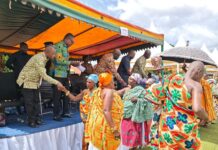A new agriculture report has revealed that the expanding role of technology in the sector creates significant opportunities for investment.
The report said digitisation was helping build comprehensive databases to support the more efficient targeting and effectiveness of government programmes.
Indeed, there are several platforms that link smallholder farmers with agricultural service providers via SMS. They aim to boost productivity and efficiency while reducing post-harvest losses,” “The Report: Ghana 2022” by the Oxford Business Group (OBG), said.
It said that other services, including crop-spraying drones and marketplace links, are now available to Ghana’s independent farmers, out-grower associations, cooperatives and agri-businesses.
Tech platforms
The report cites some technology platforms available to Ghanaian farmers and how they are leveraging them to improve production.
The first is AgroCenta, which helps to boost access to markets and finance, reducing the need for intermediaries.
It offers two platforms – CropChain, which facilitates trade between smallholder farmers and consumers. At the beginning of this year, a total of 48,000 farmers were signed up for the app, with over $500,000 worth of commodities traded.
The second platform is LendIt, which aims to boost financial inclusion among smallholder farmers with digital payments, microlending and crop insurance.
Govt services
The OBG report indicated that the private sector’s innovative solutions align with the government’s efforts to incorporate ICT and open data tools into the sector’s daily operations.
It cites the e-Agriculture programme to utilise digital technologies and open data to facilitate the delivery of more affordable, timely and efficient agricultural services, introduced by the Ministry of Food and Agriculture (MoFA).
“Specifically, it features an e-farm information hotline that farmers can call to find out how to produce the desired crop in their local language, at any time of the day; an e-field extension programme, wherein extension officers report on farming developments to facilitate an accurate and quick response to the sector’s needs; and an e-learning and resource centre, featuring training programmes and a web portal,” it said.
It said that several other government initiatives include e-agriculture components, including Planting for Food and Jobs (PFJ); Planting for Export and Rural Development; One District, One Factory and One District, One Warehouse. The PFJ, it said, included significant public funding for the MoFA’s e-Agriculture activities.
Another programme, Agenda for Jobs, sought to promote the use of ICT in the agricultural value chain to reduce costs; establish a database on all farmers, promote insurance products; disseminate information on weather and prices; and strengthen research programmes.
Prospects
The report said the impact of these efforts has been tangible.
Farmers benefitting from the subsidised fertilisers and seeds offered by the PFJ register for the service are boosting data accuracy and the monitoring of sector activity.
This in turn enables a more responsive approach from the MoFA and other agencies. Data on weather, commodity prices and transport conditions that are distributed free of charge to farmers via digital networks enable them to tailor their activities to meet current market and metrological conditions.
Pest control can also be improved, with drones used to distribute pesticides to farms with fall armyworm outbreaks.
Keynote
- The report said that with an estimated 44.7 per cent of the workforce employed in the agriculture sector, farming, forestry and fisheries are not only central activities to Ghana’s economy but are key components of society.
- It said overall, performance in the next few years strongly depends on the ability to create new methods for financing within the sector.








